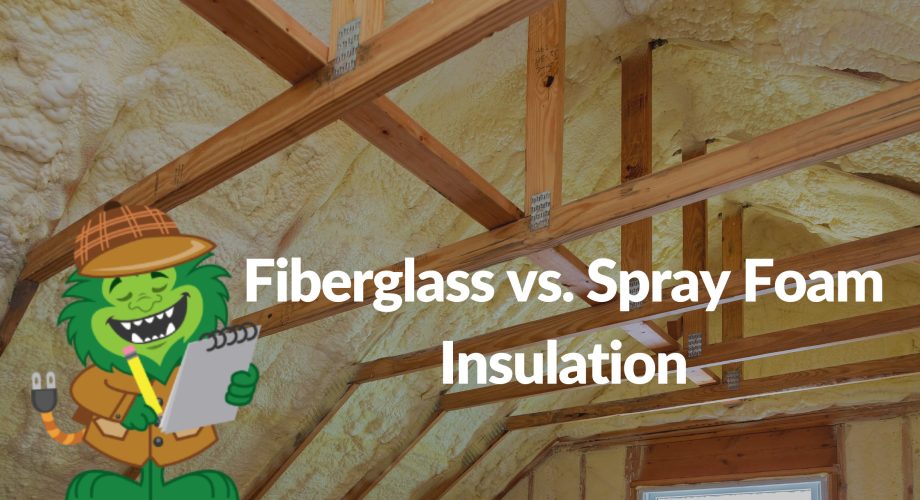Have you been considering updating your home insulation? What kind should you choose? Deciding between fiberglass vs spray foam insulation can be difficult.
Both have their unique benefits and drawbacks that you need to take into account when making your decision. Let’s break down all of the important information for you to make the best decision about which type of insulation is right for your home.
What is Fiberglass Insulation?
Fiberglass batt insulation is one of the most popular types of insulation in the industry. Made from a combination of sand and glass fibers, fiberglass insulation is used in commercial and residential construction to help keep buildings warm in the winter and cool in the summer.
Fiberglass batts are available in various thicknesses and densities, making them a versatile insulation material for a variety of applications. Installing fiberglass insulation is relatively easy, making it a popular choice for do-it-yourselfers.
However, fiberglass insulation can be irritable to the skin and lungs, so it is important to take proper precautions when working with it and always consider hiring a professional. Overall, fiberglass insulation is an effective and affordable way to improve the energy efficiency of your home or office.
What is Spray Foam Insulation?
Spray foam insulation is a type of insulation that is sprayed onto a surface. It is made up of two main ingredients: polyurethane and isocyanate. These two substances react to create a foamy substance that expands and hardens, filling in any gaps or spaces where it is sprayed.
Spray foams have a number of advantages over other types of insulation.
- It forms a tight seal that is great for air sealing and creates a vapor barrier.
- It is effective at insulating both hot and cold surfaces.
- Spray foam insulation can be used on a variety of surfaces, including walls, ceilings, and even ductwork.
Spray foam insulation is an efficient and versatile way to improve your home’s energy efficiency. Applying spray foam is not for the typical DIYer, so be sure to talk to a professional.
Open-Cell Spray Foam Insulation vs. Closed-Cell Spray Foam
One final note on spray foam insulation: there are two main types of spray foam, open-cell and closed-cell foams. Open-cell foam is less dense than closed-cell spray foam and has a lower R-value, meaning that it is not as effective at insulating as closed-cell foam. However, open-cell spray foam is more affordable and easier to install, making it a popular choice for many homeowners.
On the other hand, closed-cell spray foam is more expensive but provides better insulation and can even help to strengthen structural elements like walls and ceilings. Ultimately, the decision between open-cell and closed-cell spray foam depends on personal preference and budget.
Is Spray Foam Insulation Better Than Fiberglass?
Both have their advantages and disadvantages, so choosing the right type for your needs is important. Spray foam insulation is more effective at sealing off cracks and gaps, preventing air leakage, and saving you money on your energy bills. However, it is more expensive than fiberglass insulation and can be difficult to install. Fiberglass insulation is less expensive and easier to install, but it isn’t as effective at sealing off cracks and gaps.
So, which is the better option? It depends on your needs. If you’re looking for an affordable option that is easy to install, then fiberglass insulation is a good choice. If you’re looking for an option that will save you money on your energy bills and will last the life of your home, then spray foam insulation is the better choice.
R-Value of Spray Foam vs. Fiberglass Insulation
When choosing insulation for your home, there are many factors to consider, including R-value. R-value measures an insulation’s ability to resist heat flow, and the higher the R-value, the better the insulation.
Spray foam insulation has a higher R-value than fiberglass insulation, making it a more effective barrier against heat flow. Spray foam insulation is less likely to settle over time, meaning it will maintain its R-value over the life of your home. It also benefits from sealing gaps and cracks in your home, further preventing heat loss. For these reasons, spray foam insulation is an excellent choice for those looking for a high-performance option.
Cost of Spray Foam Insulation Compared to Fiberglass
No matter what type of home you have, insulation is important for keeping your energy costs down. Both types of insulation have different costs, but which one is right for your budget?
Spray foam insulation is typically more expensive than fiberglass insulation, but it also has several advantages accounting for the higher bill. For example, spray foam insulation forms a tight seal that can help create an air barrier and prevent cold air from seeping out in the summer. Additionally, it provides superior soundproofing qualities, making it an excellent choice for people who live in noisy areas.
Fiberglass insulation is more affordable and easier to install, making it a popular choice for budget-minded homeowners. Fiberglass insulation does not provide as much protection against air leaks and does not offer the same level of soundproofing as spray foam insulation, but can still be an effective option for your home. When making your decision, be sure to weigh the cost of each type of insulation against its benefits to find the option that best suits your needs.
Can Your Use Spray Foam Insulation and Fiberglass Insulation Together?
If you’re looking for the best way to insulate your home, you may wonder if you can use spray foam insulation and fiberglass insulation. The short answer is yes, you can use both types of insulation together to create a well-insulated home. Both can be used effectively in different locations in your home. For example, fiberglass insulation is often used in attics and crawl spaces, while spray foam insulation is used in walls and ceilings. When used together, these two types of insulation can create an impenetrable barrier against heat loss, saving you money on your energy bills.
Get Expert Advice From Your Local Energy Monster Team
Now that we’ve talked about both fiberglass and spray foam insulation, which one checks off all of your needs? That’s where Energy Monster comes in. We’re experts in insulation materials, and we can provide you with all the information you need to make the best decision for your home. We can also install the insulation for you, so you don’t have to worry about anything. We can give you some energy-saving tips to help you lower your heating and cooling costs and the proper installation of your new home insulation. So if you’re not sure what type of insulation is right for you, contact Energy Monster today. We’ll be happy to help!

